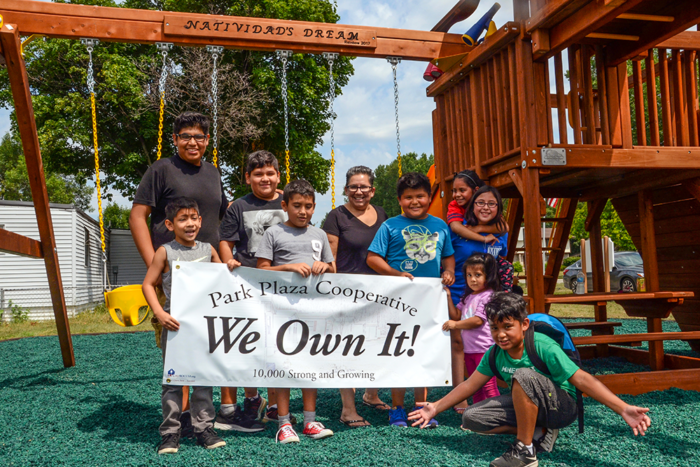
Doug O’Brien, President and CEO of NCBA CLUSA moderated the discussion, noting the rapidly resurging interest in and development of cooperative housing.
NCBA CLUSA recently released several policy resources to encourage investments in cooperative development at the federal level. Our recommendations to Congress and President-Elect Joe Biden, including stronger investments to support cooperative housing at the Department of Housing and Urban Development is available here. A comprehensive policy strategy to build a more inclusive economy using cooperatives, with support from the Urban Institute, is available here.
Resident-owned communities
Danielle Maiden, Resident-Owned Community Program Manager for NeighborWorks Montana, began her presentation discussing the shortage of affordable housing in Montana—ranking 40th in the nation—where nearly one-third of residents are cost-burdened and disproportionately impacting Indigenous communities and people with disabilities. The lack of affordable housing is worsening for people who live and work in Montana because of the migration shifts as a result of the onset of the COVID-19 pandemic as well as private equity firms purchasing land and homes for quick profits.
NeighborWorks Montana is taking a number of steps to help address these challenges for Montanans, including statewide partnerships for housing education, community land trusts, Community Development Financial Institution (CDFI) lending, and helping residents of manufactured home parks purchase the land and create resident-owned communities.
NeighborWorks Montana is also working to educate and help organize residents of manufactured home parks on ROC opportunities and enact laws to create opportunity to purchase laws that give residents the right of first refusal when land is put up for sale.
Maiden noted that manufactured housing is the only non-subsidized form of affordable housing in the country. Across the U.S., resident-owned communities have formed in 22 states, accounting for 18,000 homes converted to homeownership using the ROC model. In Montana, ROCs have been used for 11 years and now thrive in 14 communities in the state, totaling 577 households. There are 469 manufactured home parks in total in Montana, of which 60 percent of them are defined as ‘small’ parks of 24 units or less. As a result, NeighborWorks Montana has adapted their work to accommodate small parks in communities of 11 and 12 homes each.
Finally, NeighborWorks Montana has worked extensively to build out community land trusts. Using this tool, the non-profit is able to permanently preserve affordable housing opportunities. Moreover, they’ve partnered with Trust Montana, a statewide land trust with organizations like Habitat for Humanity and others working toward long-term, sustainable affordable housing solutions.
Limited equity housing cooperatives
Next, the presentation featured Andy Reicher, Executive Director of the Urban Homesteading Assistance Board to discuss limited equity housing cooperatives. UHAB began nearly 50 years ago when New York City was experiencing significant housing abandonment, often in neighborhoods that had also been the greatest victims of redlining, a discriminatory lending practice in which financial institutions did not equitably provide loans in low-income, minority communities. When the housing units were turned over to the city because landlords did not pay their taxes, UHAB supported residents in the community organize and collectively purchase the buildings and improve them with sweat equity as their down payment and affordable financing support from the city – a process to become known as urban homesteading. The process resulted in thousands of limited equity housing co-ops.
As the process by the city has evolved to more quickly acquire resident-occupied buildings from delinquent landlords, UHAB has remained steadfast in their support to residents to purchase the building and create a co-op. The down payment for these limited equity co-ops usually range between $250 and $2,500 per share.
UHAB provides “people development” through technical assistance, ongoing training and support to the residents to support governance and management by the residents and Boards of Directors to ensure the co-ops can be sustainable for the long-term.
UHAB also conducted a census of limited equity housing cooperatives across the country—half of the 300,000 housing cooperatives in New York City alone. Unfortunately, about half of the co-ops created lost their affordability because federal programs expired, and in their census, UHAB found that half of the remaining limited equity housing cooperatives face that same risk in the near future.
Reicher stressed the importance of cooperative-specific financing to support people in purchasing shares of their cooperative as well as for maintenance and improvements of the cooperative building itself.
Student housing cooperatives
Kim Garmany, Executive Director of College Houses, President of North American Students of Cooperation (NASCO) Development Services and a member of the Board of Directors for NCBA CLUSA, spoke next about cooperative housing for students.
Student housing cooperatives are generally non-profit organizations that are governed cooperatively by the members. Residents purchase their co-op share and are extended the rights of a member-owner, including participating in the budgeting process. Currently NASCO has 532 members.
Garmany highlighted that co-ops pop up in times of crisis. In student housing, there was a rise in the 1930s, 1960s, and now a new wave of development in the last decade.
Much of the earlier development using the ownership model of student housing cooperatives was with the support of the Department of Housing and Urban Development’s College Housing Program. While affordability was an important component, many student cooperatives were developed out of shared social values – sustainability, community and voice. Student housing cooperatives have provided people with valuable life and leadership skills, including civic engagement, budgeting, and providing stability in times of transition.
In the 1990s, student housing cooperatives began to expand to community cooperatives. Student housing co-ops are pivoting as a result of the COVID-19 pandemic when, in about one week’s time of universities transitioning to remote learning, co-ops lost half their members. Co-op Boards adapted by creating resilience funds to provide direct financial assistance and modified their operations and safety guidelines to meet and exceed public health requirements.
During the presentation, one viewer noted, “As a working-class kid of a single-parent household, those co-ops made it possible for me to afford to eat and sleep in an otherwise very expensive town.”
One student housing co-op closed, but the group used the setback as an opportunity to expand their service and presence in the community. Recently, they joined the Ending Community Homelessness Coalition, an organization that coordinates transitioning young people out of homelessness, providing stability in housing and agency in their lives and living environments. NASCO Development Services is continuing the work to preserve housing for the next generation and looking to expand their work to see which other demographics might benefit from this work.
Financing cooperative housing
Finally, the panel featured Casey Fannon, President and Chief Lending Officer at the National Cooperative Bank.
Housing co-op financing has two key aspects: share loans and underlying mortgage. Share loans are similar to single-family mortgages, provided to an individual resident to purchase their share in the cooperative. There are unique aspects to share loan lending due to the cooperative structure: project approval to make sure the co-op itself is sound with proper insurance and financially stable as well as the underlying mortgage which is supported by the fees paid by member-owners. The collateral for the lending institution is a share in the cooperative.
The biggest underwriting difference is that co-ops seek to generate a break-even cashflow, as opposed to investor-owned housing units that are driven by profits.
Share loans and underlying mortgage loans are inter-related. In limited equity housing cooperatives, the underlying mortgage is much greater than the share loans, which shifts the debt from the individual to the co-op to reduce the barrier to joining the cooperative.
Fannon described underlying co-op mortgages as the safest asset class in the real estate space. Share loans similarly outperform the market. When delinquencies rise in the market, share loan delinquencies rise at a lower rate than other mortgages. As we begin to see deferrals and forbearances due to COVID-19 impacts, the National Cooperative Bank portfolio remains strong, and its deferrals and forbearances are less than half of the Fannie Mae metrics. The horizontal support of a cooperative helps to build a more resilient model.
Fannon also noted that there is an immense opportunity for investments in housing cooperatives in the wake of the pandemic to build more sustainable and inclusive economics through cooperatives. “Every city and state is looking for resilient models…and co-ops can really anchor these communities,” he said. Fannon concluded his remarks urging congressional action to support a greater emphasis on housing cooperatives, including leveling the playing field and promoting cooperatives in housing and small business, grant and affordable loan opportunities for co-op housing, and technical assistance to support the development and launch of housing cooperatives.
Policy discussion
The conversation concluded with a policy conversation around what is most critical to support people in using cooperatives as an affordable housing solution.
Andy Reicher highlighted the need to ensure housing co-ops are equally eligible for federal programs. While housing co-ops are not eligible for disaster recovery to housing at the Federal Emergency Management Agency (FEMA), they were similarly ineligible under the Paycheck Protection Program at the Small Business Administration (SBA). Veterans Administration loans also are not eligible to be used on housing cooperatives.
He also noted that more than half of all limited equity housing cooperatives expire soon. While they may remain co-ops, the cost of housing can increase significantly. The federal, state and local government should be providing incentives to capture those tens of thousands of affordable housing through tax incentives and affordable loans.
Kim Garmany recommended re-funding the College Housing Program. Co-ops and co-op organizations were more active stewards of the program than universities, and their work has made a significant, long-term impact creating and maintaining affordable housing solutions for college students. An important component is also increasing understanding of the potential economic and social benefits of cooperative housing.
Danielle Maiden focused on action needed by state and local governments to create tax incentives for people who sell their property to residents or donate land to a community land trust, including paying less on state capital gains taxes. Montana has implemented this state capital gains benefit. In Montana, advocacy efforts are also centered on implementing opportunity to purchase laws to require owners to notify residents of their intent to sell and allow a period of time for residents to make an offer to purchase.
The conversation concluded with remarks around cooperatives practicing diversity, equity and inclusion through their work – fighting back against a legacy of discriminatory practices and those that still exist, creating scholarship funds for greater educational opportunity among historically disadvantaged and underserved groups, and meeting people where they are to make the cooperative business model work for them.
In 2019, NCBA CLUSA Board of Directors adopted a resolution supporting efforts to ensure that diversity, equity and inclusion are clearly understood and enacted priorities within the Cooperative Identity.


